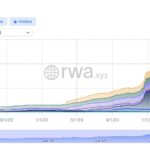In a surprising twist for the decentralized finance landscape, Sky, the protocol formerly known as MakerDAO, reported a staggering first-quarter loss of $5 million. This downturn follows a profitable last quarter, where the protocol had posted gains of $31 million. The primary catalyst for this financial shift appears to be the significant rise in interest payments to token holders, which surged by 102%. This increase is attributed to Sky’s efforts to boost the adoption of its new Sky dollar stablecoin (USDS), offering a higher savings rate that attracted many investors.
According to Rune Christensen, Sky’s co-founder, the Sky Savings Rate was kept at an eye-popping 12.5%, far surpassing market averages, which led to impressive inflows. However, as interest rates were adjusted to 4.5% in February, the retention of these investors raised questions about long-term sustainability. The protocol’s operational mechanics resemble those of a traditional bank, needing to lend out funds at higher rates than it pays to savers. Yet, the push for USDS—aimed at sophisticated investors—has not generated the anticipated market demand. PaperImperium, a governance liaison at GFX Labs, emphasized that while DAI continues to perform well profit-wise, USDS remains a challenging asset for Sky’s profitability.
Launched as part of Sky’s broader Endgame plan, USDS was designed to cater to a specific audience, particularly institutional investors seeking regulatory compliance. Despite this strategy, there’s uncertainty surrounding USDS’s ability to attract new users. Although the combined supply of USDS and DAI saw a noticeable increase of 57% since the quarter’s start, much of this growth originated from external protocols like Ethena, which redirected significant funds into staked USDS.
“USDS is a major drag on earnings,” PaperImperium noted. “DAI makes money. USDS, not so much.”
Recent movements in the market have further complicated the situation. Ethena’s recent shift from USDS to another stablecoin, USDtb, intends to stabilize its reserves while potentially alleviating some financial burdens on Sky. With the evolving state of both USDS and DAI, the coming months will be critical for Sky as it navigates these financial challenges and works towards a more decentralized and resilient ecosystem.

Sky’s Financial Performance and Market Strategy
The recent financial status of the DeFi savings protocol Sky reveals significant shifts that may impact users and investors in decentralized finance. Here are the key points derived from the developments:
- First Quarter Loss
- Sky reported a loss of $5 million in Q1 after interest payments to token holders more than doubled.
- This contrasts starkly with the $31 million profit reported in the previous quarter.
- Interest Payment Dynamics
- Interest payments increased by 102% due to incentives for using the new Sky dollar stablecoin (USDS).
- The Sky Savings Rate was initially high at 12.5%, attracting significant inflows before being lowered to 4.5%.
- Protocol Functionality
- Sky operates similarly to a traditional bank, needing to lend at higher rates than it pays to savers.
- High rates on USDS without sufficient demand negatively affected profitability.
- Endgame Initiative
- The transition to USDS aims to create a more decentralized, compliant system, targeting sophisticated investors.
- It remains uncertain if USDS has captured a significant new user base.
- Supply Situation
- The total supply of USDS and DAI increased by 57% since the start of the quarter, partially due to Ethena’s involvement.
- Ethena’s recent switch from USDS to USDtb may reduce Sky’s interest payout obligations in the future.
The current financial performance and strategic changes at Sky serve as a reminder of the volatility and complexity inherent in DeFi investments. Users need to stay informed about these developments to make educated decisions regarding savings protocols.
Sky’s DeFi Dilemma: Navigating Interest Rates and Stablecoin Adoption
The recent financial struggles of the DeFi savings protocol, Sky, formerly MakerDAO, have sparked a fascinating discussion about the competitive landscape of decentralized finance. After posting a hefty $5 million loss in the first quarter, primarily due to soaring interest payments linked to the newly launched Sky dollar stablecoin (USDS), a comparison with other DeFi projects reveals both vulnerabilities and potential advantages in their strategic approaches.
On the positive side, Sky has positioned itself as a high-yield option, with an enticing 12.5% savings rate that initially drew significant inflows. This compelling interest rate strategy could attract attention from investors seeking better returns than traditional savings accounts can offer. However, as interest rates were adjusted downward to 4.5%, the resulting decrease could lead to a potential erosion of trust among users who flocked to high returns. Unlike some competitors who maintain steady yields or lower volatility in their financial models, Sky’s sharp decline demonstrates inherent risks in creativity over caution.
Moreover, the shift to USDS, designed to appeal to sophisticated investors such as hedge funds and family offices, highlights Sky’s ambition to cater to a different clientele. However, as observed, new user adoption has been lackluster. This situation poses a double-edged sword. While the rebranding may attract institutional players eventually, the immediate need to incentivize current holders of DAI with higher payouts on USDS is straining profitability. Other DeFi protocols might benefit from Sky’s missteps, as they could market more sustainable approaches that balance user incentives with healthy profit margins.
Additionally, the interaction with external systems like Ethena adds complexity. While Ethena’s inflow appears to bolster USDS supply, the recent decision to transition reserves towards a BlackRock-backed digital stablecoin could signal volatility not just for Sky, but for the broader DeFi market. This could create openings for competing platforms to assert their stability and reliability, appealing to users wary of the rapid shifts in currency dynamics within Sky’s ecosystem.
Ultimately, Sky’s situation is a cautionary tale for similar platforms navigating the delicate balance between growth and risk management. The disparities in interest yields and adoption rates clearly illustrate an opportunity for other DeFi projects to capitalize on user uncertainties regarding Sky’s fluctuating financial health. Investors seeking safer, more consistent outcomes may feel compelled to gravitate towards competitors who maintain stability amidst shifting landscapes. In a space where trust is paramount, how these narratives unfold will be pivotal for investor confidence across the DeFi sector.

















